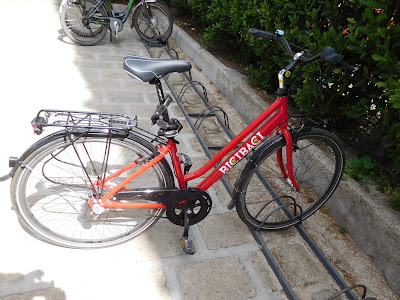So..After ten days of hot and mostly dry weather in Italy, I came home to...a week of hot--and humid--weather in New York, punctuated by rain.
Yesterday was a respite. I could not have asked for better cycling weather. When I started, the skies were partly cloudy and the temperature was 17C. The skies cleared along the way and the temperature increased a bit, but I was pedaling into 20-25 kph wind most of the way. Still, I barely sweated all the way to Connecticut, where the sky was overcast.
On my way home, the clouds broke for some sun, but I didn't feel the need to replenish my sunscreen. I think the temperature reached about 26C by the time I finished, in mid-afternoon.
The ride was completely pleasant and uneventful. I was riding Arielle, my Mercian Audax, so it could hardly have been smoother or more effortless. Although it's a drop-bar all-arounder road bike, I felt less strain on me than I did when I was riding an upright bike in Rome. It probably has to do with the Mercian's fit. Also, being a lighter bike, it's simply easier to pedal in higher gears. Most of all, it's my bike, so even when I don't ride it for a couple of weeks (or months, as sometimes happens during the winter), it takes me no time to re-acclimate myself to it.
So, which is better: Going to faraway places and riding among sights you will rarely, if ever, experience again--or riding a bike you know and love on a route you know?
Such a dilemma! It used to be so much easier back in the day, when most airlines (the non-US carriers, anyway) would take your boxed bike (with pedals, front wheel and handlebars removed) as one of your pieces of luggage as long as it, and whatever else you brought, was within the weight limit. For most European carriers--as well as Air India, Air Pakistan (yes, I flew them to Europe), that limit was 44 kilos.
These days, it seems, airlines don't want you to bring your bike, or charge some exorbitant fee for it. I figured that for a ten-day trip, it was easier to rent a bike, especially since I wasn't going across the countryside with loaded panniers and camping gear.
Of course, the obvious solution would be to get one of those bikes that travels easily like Bike Friday or Brompton, which would cost about as much as going on a trip somewhere. Or, perhaps, there's some other way to take Arielle or one of my other bikes across the seas with me.
That would make my choices a little easier. Then again, when I come home from a Connecticut ride--or one to Point Lookout or the Jersey Shore--Max and Marlee are waiting for me!
Yesterday was a respite. I could not have asked for better cycling weather. When I started, the skies were partly cloudy and the temperature was 17C. The skies cleared along the way and the temperature increased a bit, but I was pedaling into 20-25 kph wind most of the way. Still, I barely sweated all the way to Connecticut, where the sky was overcast.
On my way home, the clouds broke for some sun, but I didn't feel the need to replenish my sunscreen. I think the temperature reached about 26C by the time I finished, in mid-afternoon.
The ride was completely pleasant and uneventful. I was riding Arielle, my Mercian Audax, so it could hardly have been smoother or more effortless. Although it's a drop-bar all-arounder road bike, I felt less strain on me than I did when I was riding an upright bike in Rome. It probably has to do with the Mercian's fit. Also, being a lighter bike, it's simply easier to pedal in higher gears. Most of all, it's my bike, so even when I don't ride it for a couple of weeks (or months, as sometimes happens during the winter), it takes me no time to re-acclimate myself to it.
So, which is better: Going to faraway places and riding among sights you will rarely, if ever, experience again--or riding a bike you know and love on a route you know?
Such a dilemma! It used to be so much easier back in the day, when most airlines (the non-US carriers, anyway) would take your boxed bike (with pedals, front wheel and handlebars removed) as one of your pieces of luggage as long as it, and whatever else you brought, was within the weight limit. For most European carriers--as well as Air India, Air Pakistan (yes, I flew them to Europe), that limit was 44 kilos.
These days, it seems, airlines don't want you to bring your bike, or charge some exorbitant fee for it. I figured that for a ten-day trip, it was easier to rent a bike, especially since I wasn't going across the countryside with loaded panniers and camping gear.
Of course, the obvious solution would be to get one of those bikes that travels easily like Bike Friday or Brompton, which would cost about as much as going on a trip somewhere. Or, perhaps, there's some other way to take Arielle or one of my other bikes across the seas with me.
That would make my choices a little easier. Then again, when I come home from a Connecticut ride--or one to Point Lookout or the Jersey Shore--Max and Marlee are waiting for me!



































